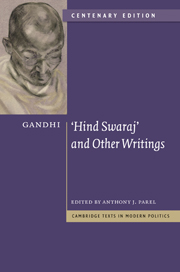Book contents
- Frontmatter
- Contents
- Preface to the centenary edition
- Acknowledgements
- Editor's introduction to the centenary edition
- Editor's introduction to the 1997 edition
- A note on the history of the text
- Principal events in Gandhi's life
- Biographical synopses
- Guide to further reading
- Glossary and abbreviations
- HIND SWARAJ
- Contents
- Preface to the English translation
- Foreword
- I The Congress and its officials
- II The Partition of Bengal
- III Discontent and unrest
- IV What is Swaraj?
- V The condition of England
- VI Civilisation
- VII Why was India lost?
- VIII The condition of India
- IX The condition of India (cont.): railways
- X The condition of India (cont.): the Hindus and the Mahomedans
- XI The condition of India (cont.): lawyers
- XII The condition of India (cont.): doctors
- XIII What is true civilisation?
- XIV How can India become free?
- XV Italy and India
- XVI Brute force
- XVII Passive resistance
- XVIII Education
- XIX Machinery
- XX Conclusion
- I APPENDICES
- SUPPLEMENTARY WRITINGS
- Bibliography
- Index
IV - What is Swaraj?
Published online by Cambridge University Press: 05 October 2014
- Frontmatter
- Contents
- Preface to the centenary edition
- Acknowledgements
- Editor's introduction to the centenary edition
- Editor's introduction to the 1997 edition
- A note on the history of the text
- Principal events in Gandhi's life
- Biographical synopses
- Guide to further reading
- Glossary and abbreviations
- HIND SWARAJ
- Contents
- Preface to the English translation
- Foreword
- I The Congress and its officials
- II The Partition of Bengal
- III Discontent and unrest
- IV What is Swaraj?
- V The condition of England
- VI Civilisation
- VII Why was India lost?
- VIII The condition of India
- IX The condition of India (cont.): railways
- X The condition of India (cont.): the Hindus and the Mahomedans
- XI The condition of India (cont.): lawyers
- XII The condition of India (cont.): doctors
- XIII What is true civilisation?
- XIV How can India become free?
- XV Italy and India
- XVI Brute force
- XVII Passive resistance
- XVIII Education
- XIX Machinery
- XX Conclusion
- I APPENDICES
- SUPPLEMENTARY WRITINGS
- Bibliography
- Index
Summary
reader: I have now learnt what the Congress has done to make India one nation, how the Partition has caused an awakening, and how discontent and unrest have spread through the land. I would now like to know your views on Swaraj. I fear that our interpretation is not the same.
editor: It is quite possible that we do not attach the same meaning to the term. You and I and all Indians are impatient to obtain Swaraj, but we are certainly not decided as to what it is. To drive the English out of India is a thought heard from many mouths, but it does not seem that many have properly considered why it should be so. I must ask you a question. Do you think that it is necessary to drive away the English, if we get all we want?
reader: I should ask of them only one thing, that is: ‘Please leave our country.’ If after they have complied with this request, their withdrawal from India means that they are still in India, I should have no objection. Then we would understand that, in our language, the word ‘gone’ is equivalent to ‘remained’.
editor: Well, then, let us suppose that the English have retired. What will you do then?
reader: That question cannot be answered at this stage. The state after withdrawal will depend largely upon the manner of it. If, as you assume, they retire, it seems to me we shall still keep their constitution, and shall carry on the government.
- Type
- Chapter
- Information
- Gandhi: 'Hind Swaraj' and Other Writings , pp. 25 - 28Publisher: Cambridge University PressPrint publication year: 2009
- 2
- Cited by

